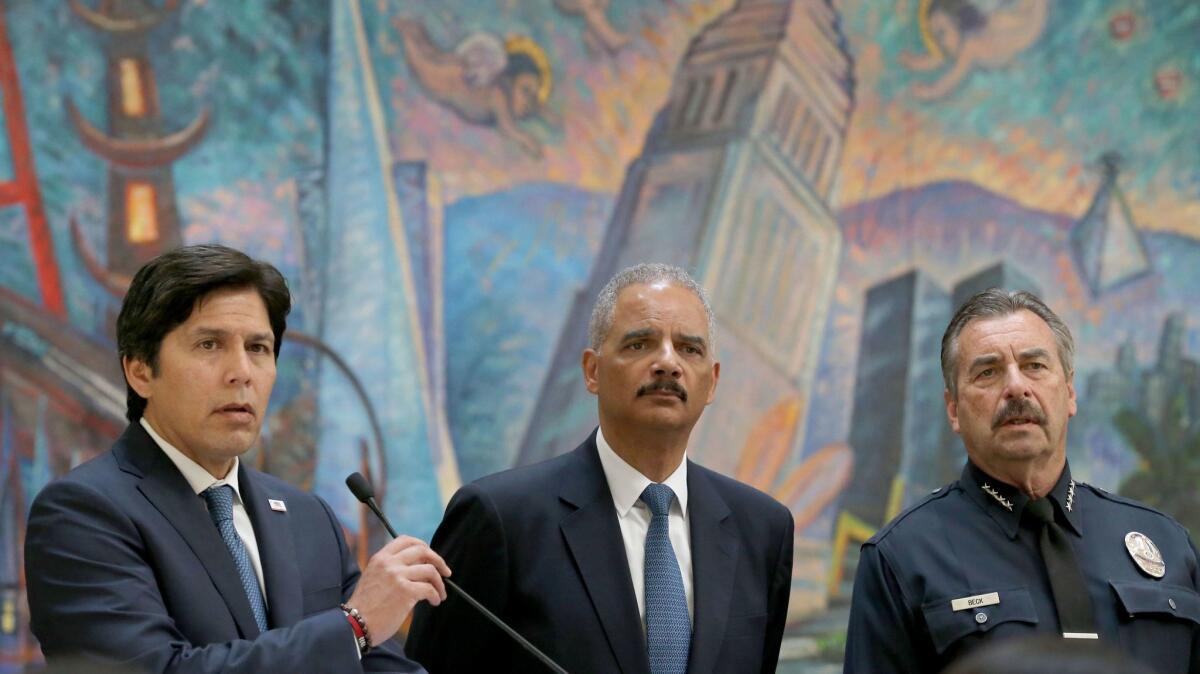How California’s Trust Act shaped the debate on the new ‘sanctuary state’ proposal

- Share via
Over the past few months, immigrant advocates have rallied at sheriff’s departments, marched to the state Capitol and occupied the governor’s office in a push for a California Senate bill that would limit law enforcement from questioning or holding people on immigration violations.
The so-called sanctuary state bill, by Senate leader Kevin de León (D-Los Angeles), has drawn both national praise and rebuke, touted as part of a legislative package by
But Gov.
For those who remember the passage of the bill’s predecessor, the California Trust Act, the debate is familiar. Like de León’s legislation, the Trust Act was introduced by Democrats to blunt the impact of federal policy on immigrant communities. And it also ignited a bitter fight over who the state should protect when the federal government casts a wide deportation net that can entangle hardworking families and criminals alike.
The Trust Act, which was signed by Brown in October 2013, prohibits state and local law enforcement from holding people longer than 48 hours for federal immigration agents — unless they’ve been convicted of certain crimes, most of them serious or violent.
With SB 54, de León seeks to further limit which inmates officials can detain for
But sheriffs argue SB 54 would hamper cooperation between law enforcement officials, allowing immigrants with violent or serious convictions to walk free. Immigrant rights advocates counter that the state needs to do more to keep people from being punished twice — once under criminal laws and again through deportation — in a time of fear for immigrant communities.
Here is how the Trust Act has shaped this year’s debate on SB 54:
Rebuilding trust in police
Before sheriffs lobbied against SB 54, they were among the most vocal opponents to the Trust Act. Former San Francisco Assemblyman
Under the 2008
Obama administration officials said Secure Communities was intended to identify immigrants without legal status who had been convicted of serious crimes, such as murder, rape and kidnapping. But national debate raged over the number of immigrants law enforcement officials were targeting, spurring legal challenges to the constitutionality of the program and to whether cities and states could opt out of it.
In California, where then-Atty. Gen. Brown signed a memorandum to enter the state in Secure Communities, Ammiano and other Democrats argued the program was ensnaring many people who had not been convicted of any crimes or were low-level offenders.
The first version of the Trust Act would have blocked state and local law enforcement from sharing fingerprints with ICE. But Ammiano later amended the bill to narrow the list of offenders who local and state officers could legally detain for the federal agency.
The California Sheriffs’ Assn. warned that by barring state and local officers from complying with “detainers,” or official requests to hold offenders for ICE, it would prevent agencies from working together to keep many serious criminals behind bars.

Top federal immigration officials also tried to privately lobby Brown to veto the legislation after it had passed both chambers of the Legislature.
In emails obtained by the Advancing Justice-Asian Law Caucus and the National Day Laborer Organizing Network, then-ICE director John Morton and senior ICE officials proposed that Brown hold off approving the bill while the federal agency developed an alternative pilot program in California to limit which immigrants police and sheriffs could detain. They said the program would influence national policy.
A staffer with the governor’s office rejected ICE’s proposal in a September 2012 email. Even so, Brown vetoed Ammiano’s bill a few days later. In his message, the governor echoed the concerns of sheriffs, saying the list of offenses for which local agencies could hold inmates for federal officials was “fatally flawed” because it omitted many serious crimes, including child abuse, drug trafficking and selling weapons.
“I believe it’s unwise to interfere with a sheriff’s discretion to comply with a detainer issued for people with these kinds of troubling criminal records,” Brown wrote, pledging to work with legislators the following year to address the concerns.
Balancing act
A year later, Brown received national attention when he signed a new version of the Trust Act as opposition against the Secure Communities program continued to gain momentum.
Across the country, other governors, mayors and some police officials were looking for their own ways to limit their participation in the federal program. Police and immigration officials working closely together created a chilling effect, they said, making immigrant crime victims and witnesses reluctant to come forward.
Weeks of tough negotiations with police and sheriff’s associations went into crafting the final bill, which prohibited California law enforcement agencies from holding immigrants for ICE unless they were charged with one of an expanded list of roughly 800 crimes. Among those barred from release were immigrants with past serious or violent felonies, registered sex and arson offenders, domestic violence abusers and those charged with certain other felonies.
Not all sides were satisfied with the compromise. Some sheriffs argued the list of offenses was still not long enough. Immigrant rights advocates were dismayed it included so many crimes, including nonviolent drug charges and “wobblers,” offenses that could be charged as either a felony or misdemeanor.
But the limits of the Trust Act were not fully tested when Secure Communities came to an end a few months later.
In September 2014, a federal court held an Oregon county liable for damages after officials detained an inmate past her release date in order to turn her over to ICE. The court decision prompted hundreds of cities and counties around the country to stop complying with immigration-hold requests before then-President Obama ended Secure Communities that year.
ICE officials rebooted the program as the Prioritized Enforcement Program, which allowed immigration agents to ask local law enforcement agencies for immigrant offenders’ release dates so ICE could detain them when or before they were set free. It also directed ICE to prioritize its requests to transfer or detain immigrants convicted of certain crimes, who posed a danger to national security or who recently entered the U.S. without permission.
Under the Trust Act, cities and counties have the discretion to further narrow the list of crimes for which their authorities can hold people for ICE, but it does not allow them to expand it.
“The good thing about the Trust Act was that if localities want to, they can adopt policies that set a higher standard, more protections for immigrants,” said Angela Chan, policy director at the Asian Law Caucus. That, she said, allowed for “the San Franciscos and Santa Claras of the state,” so-called sanctuary cities and counties where local laws limit collaboration between local authorities and federal immigration officials.

A new era under Trump
In its first seven months, the Trump administration has reinstated the Secure Communities program, canceled a temporary immigration relief program for people brought into the country illegally as children and pledged to slash funding from local law enforcement agencies that refuse to collaborate with federal immigration agencies.
Advocates, social workers and pastors once more are asking the state to intervene on behalf of immigrant communities. But the debate over whether local and state officials should be able to provide information to ICE and hold more serious offenders continues.
On NBC’s “Meet the Press,” Brown called SB 54 a “balancing act,” saying it needs more changes to win his approval. What those are remains uncertain, but some proposed changes that have been circulated at the state Capitol would allow federal immigration agents to continue entering state prisons and working with corrections officials.
Brown also has been in talks with Los Angeles County Sheriff Jim McDonnell and other members of the California Sheriff’s Assn., who argue the bill’s limits on communication could hamper local and federal officers working on transnational crime and human trafficking cases.
McDonnell said that could lead to “drug dealers and known gang members being released to our streets.”
Immigrant rights groups counter that when victims and witnesses don’t trust local police, entire neighborhoods suffer. In cities across the state, they say, some parents without legal residency are keeping their children home from school. Families have stopped seeking food assistance and other social services. Churches are offering legal aid in basements to people fearing deportation.
Ammiano said the Trust Act was sufficient for its time, “when Donald Trump was not president.”
“Brown expounds a lot about Trump,” the former assemblyman said. “If anybody should understand that [SB 54] needs to be as strong as possible to address not only the time, but the future, it should be him.”
To read the article in Spanish click here
ALSO
What you need to know about California's 'sanctuary state' bill and how it would work
Get the L.A. Times Politics newsletter
Deeply reported insights into legislation, politics and policy from Sacramento, Washington and beyond. In your inbox three times per week.
You may occasionally receive promotional content from the Los Angeles Times.








